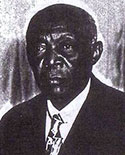A Visit to Houston (1927-1954, Section 3)
Lorenzo J. Greene, a civil rights activist from Jefferson, Missouri, traveled through Houston and other southern cities in 1930 with Carter G. Woodson. Their trip had a dual purpose. They hoped to sell books promoting African-American history for Dr. Woodson’s Associated Publishers. They also collected additional information on the anthropological history of African Americans. Dr. Greene later earned his doctorate from Columbia University in 1942 and became a leading historian on the history of blacks in America. Dr. Woodson, the son of former slaves, was the second African American to earn a doctorate at Harvard in 1912. W.E.B. DuBois was the first in 1895. Dr. Woodson is considered the father of African-American history.
Lorenzo Greene kept a diary during the year and wrote about the influential black Houstonians he met, including a few African-American physicians. Mr. Greene already knew two doctors, Dr. J. G. (Joe) Gathings and Dr. Peacock, from their undergraduate days at Howard University. Dr. Gathings had been in Houston for only two years when Mr. Greene arrived, but Greene called him “[o]ne of the best surgeons” in the city. 1 Dr. Gathings later became a Rosenwald fellow in Dermatology and Syphilology at the New York Skin and Cancer Hospital from 1941 to 1943. As part of a broad-based philanthropic agenda, the Julius Rosenwald Fund established a fellowship program in 1928 that enabled hundreds of African Americans to obtain graduate and professional education.
During his 1930 visit, Lorenzo Greene found that some 20,000 black Houstonians were unemployed. Those who found employment had been relegated often to back-breaking, poor-paying jobs, such as housekeeping or trash collection, although with the economic downturns of the Great Depression, they now faced competition for those jobs from workers of other races. “Even farm labor [was] being rapidly taken away from Negroes.” 2
During his visit to Houston, Lorenzo Greene also met Dr. Benjamin Covington. By 1930, Dr. Covington had been practicing medicine for nearly thirty years. From his visit with Dr. Covington and despite existing economic difficulties, Mr. Greene concluded that Houston’s African Americans had a greater chance for improvement than others in the South because, while segregated, the school system and library for blacks in Houston were better than those in other cities he had visited. Dr. Covington agreed about the quality of those institutions, but remained pessimistic because other problems, such as the racist sentiments expressed toward black women, subtracted from the city’s other advantages. Despite such racist sentiments, Mr. Greene felt that the race relations in Houston were relatively good for a southern city.


